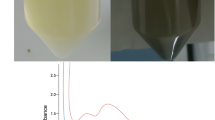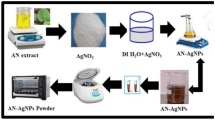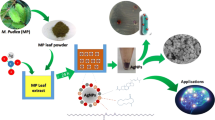Abstract
The increased emergence of antibiotic-resistant bacteria is a serious health problem worldwide. In this sense, silver nanoparticles (AgNPs) have received increasing attention for their antimicrobial activity. In this context, the goal of this study was to produce AgNPs by a green synthesis protocol using an aqueous leaf extract of Schinus areira as biocomposite to later characterize their antimicrobial action. The nanomaterials obtained were characterized by UV‒vis spectroscopy, DLS, TEM, and Raman, confirming the presence of quasi-spherical AgNPs with a negative surface charge and diameter around 11 nm. Afterward, the minimum inhibitory and bactericidal concentration of the AgNPs against Staphylococcus aureus and Escherichia coli were obtained, showing high antibacterial activity. In both of the examined bacteria, the AgNPs were able to raise intracellular ROS levels. In E. coli, the AgNPs can harm the bacterial membrane as well. Overall, it can be concluded that it was possible to obtain AgNPs with colloidal stability and antibacterial activity against Gram-positive and Gram-negative bacteria. Our findings point to at least two separate mechanisms that can cause cell death, one of which involves bacterial membrane damage and the other of which involves intracellular ROS induction.








Similar content being viewed by others
Data Availability
All the data generated or analyzed during this study are included in this published article (and its supplementary information files). Row data generated will be available from the authors upon reasonable request.
References
Le Ouay, B., & Stellacci, F. (2015). Antibacterial activity of silver nanoparticles: A surface science insight. Nano Today, 10, 339–354. https://doi.org/10.1016/j.nantod.2015.04.002
Rodrigues, G. R., López-Abarrategui, C., de la Serna, G. I., Dias, S. C., Otero-González, A. J., & Franco, O. L. (2019). Antimicrobial magnetic nanoparticles based-therapies for controlling infectious diseases. International Journal of Pharmaceutics, 555, 356–367.
Rai, M., Yadav, A., & Gade, A. (2009). Silver nanoparticles as a new generation of antimicrobials. Biotechnology Advances, 27, 76–83. https://doi.org/10.1016/j.biotechadv.2008.09.002
Marambio-Jones, C., & Hoek, E. M. V. (2010). A review of the antibacterial effects of silver nanomaterials and potential implications for human health and the environment. Journal of Nanoparticle Research, 12, 1531–1551. https://doi.org/10.1007/s11051-010-9900-y
Halbus, A. F., Horozov, T. S., & Paunov, V. N. (2017). Colloid particle formulations for antimicrobial applications. Advances in Colloid and Interface Science, 249, 134–148. https://doi.org/10.1016/j.cis.2017.05.012
Eckhardt, S., Brunetto, P. S., Gagnon, J., Priebe, M., Giese, B., & Fromm, K. M. (2013). Nanobio silver: Its interactions with peptides and bacteria, and its uses in medicine. Chemical Reviews, 113, 4708–4754. https://doi.org/10.1021/cr300288v
Duan, H., Wang, D., & Li, Y. (2015). Green chemistry for nanoparticle synthesis. Chemical Society Reviews, 44, 5778–5792. https://doi.org/10.1039/c4cs00363b
Iravani, S. (2011). Green synthesis of metal nanoparticles using plants. Green Chemistry, 13, 2638–2650. https://doi.org/10.1039/c1gc15386b
Dzul-Erosa, M. S., Cauich-Díaz, M. M., Razo-Lazcano, T. A., Avila-Rodriguez, M., Reyes-Aguilera, J. A., & González-Muñoz, M. P. (2018). Aqueous leaf extracts of Cnidoscolus chayamansa (Mayan chaya) cultivated in Yucatán México. Part II: Uses for the phytomediated synthesis of silver nanoparticles. Materials Science and Engineering: C, 91, 838–52. https://doi.org/10.1016/j.msec.2018.06.007
Sharma, D., Kanchi, S., & Bisetty, K. (2019). Biogenic synthesis of nanoparticles: A review. Arabian Journal of Chemistry, 12, 3576–3600.
Singh, A., Gautam, P. K., Verma, A., Singh, V., Shivapriya, P. M., Shivalkar, S., et al. (2021). Green synthesis of metallic nanoparticles as effective alternatives to treat antibiotics resistant bacterial infections: A review” (Biotechnology Reports (2020) 25, (S2215017X19305934), (10.1016/j.btre.2020.e00427)). Biotechnol Reports, 29, e00427. https://doi.org/10.1016/j.btre.2020.e00578
Gallucci, M. N., Fraire, J. C., FerreyraMaillard, A. P. V., Páez, P. L., Aiassa Martínez, I. M., Pannunzio Miner, E. V., et al. (2017). Silver nanoparticles from leafy green extract of Belgian endive (Cichorium intybus L. var. sativus): Biosynthesis, characterization, and antibacterial activity. Materials Letters, 197, 98–101. https://doi.org/10.1016/j.matlet.2017.03.141
FerreyraMaillard, A. P. V., Dalmasso, P. R., López de Mishima, B. A., & Hollmann, A. (2018). Interaction of green silver nanoparticles with model membranes: Possible role in the antibacterial activity. Colloids Surfaces B Biointerfaces, 171, 320–6. https://doi.org/10.1016/j.colsurfb.2018.07.044
Ahmad, S., Munir, S., Zeb, N., Ullah, A., Khan, B., Ali, J., et al. (2019). Green nanotechnology: A review on green synthesis of silver nanoparticles — An ecofriendly approach. International Journal of Nanomedicine, 14, 5087–5107. https://doi.org/10.2147/IJN.S200254
Oves, M., Rauf, M. A., Aslam, M., Qari, H. A., Sonbol, H., Ahmad, I., et al. (2022). Green synthesis of silver nanoparticles by Conocarpus Lancifolius plant extract and their antimicrobial and anticancer activities. Saudi Journal of Biological Sciences, 29, 460–471.
Mohamad, N. A. N., Arham, N. A., Jai, J., Hadi, A. (2014). Plant extract as reducing agent in synthesis of metallic nanoparticles: A review. Advanced Materials Research 832, Trans Tech Publ; p. 350–5
Yadi, M., Mostafavi, E., Saleh, B., Davaran, S., Aliyeva, I., Khalilov, R., et al. (2018). Current developments in green synthesis of metallic nanoparticles using plant extracts: A review. Artificial Cells, Nanomedicine, and Biotechnology, 46, S336–S343. https://doi.org/10.1080/21691401.2018.1492931
Woo, K. J., Hye, C. K., Ki, W. K., Shin, S., So, H. K., & Yong, H. P. (2008). Antibacterial activity and mechanism of action of the silver ion in Staphylococcus aureus and Escherichia coli. Applied and Environment Microbiology, 74, 2171–2178. https://doi.org/10.1128/AEM.02001-07
Franke, S., Grass, G., & Nies, D. H. (2001). The product of the ybdE gene of the Escherichia coli chromosome is involved in detoxification of silver ions. Microbiology, 147, 965–972. https://doi.org/10.1099/00221287-147-4-965
Bruna, T., Maldonado-Bravo, F., Jara, P., & Caro, N. (2021). Silver nanoparticles and their antibacterial applications. International Journal of Molecular Sciences, 22, 7202. https://doi.org/10.3390/IJMS22137202
Ahmad, A., Wei, Y., Syed, F., Tahir, K., Rehman, A. U., Khan, A., et al. (2017). The effects of bacteria-nanoparticles interface on the antibacterial activity of green synthesized silver nanoparticles. Microbial Pathogenesis, 102, 133–142. https://doi.org/10.1016/j.micpath.2016.11.030
Ivask, A., ElBadawy, A., Kaweeteerawat, C., Boren, D., Fischer, H., Ji, Z., et al. (2014). Toxicity mechanisms in Escherichia coli vary for silver nanoparticles and differ from ionic silver. ACS Nano, 8, 374–386.
Niazi, J. H., Sang, B.-I., Kim, Y. S., & Gu, M. B. (2011). Global gene response in Saccharomyces cerevisiae exposed to silver nanoparticles. Applied Biochemistry and Biotechnology, 164, 1278–1291.
Cutro, A. C., Castelli, M. V., López, S. N., Rosales, M. A., Hollmann, A., & Rodriguez, S. A. (2021). Chemical composition of Schinus areira essential oil and antimicrobial action against Staphylococcus aureus. Natural Product Research, 35, 2931–2936. https://doi.org/10.1080/14786419.2019.1675065
Barboza, G.,E., Cantero, J., Nuñez, C., Ariza, L. (2006). Flora medicinal de la provincia de Córdoba (Argentina) : Pteridófitas y antófitas silvestres o naturalizadas. Museo Botánico Córdoba.
Sandberg, F. (1996). 270 Plantas medicinales Ibero-americanas. 53. https://doi.org/10.1016/0378-8741(96)01417-1
Lahitte, H. B., Hurrel, J. A., Belgrano, M. J., Jankowiski, L., Halona, P., Mehltreter, K. (1998). Plantas medicinales Rioplatenses. Buenos Aires, LOLA, 240.
Lim, T. K. (2012). Schinus molle. In: Lim TK (ed). Edible med. non-medicinal plants, Dordrecht: Springer Netherlands, p. 153–9. https://doi.org/10.1007/978-90-481-8661-7_21.
Mares-Briones, F., & Rosas, G. (2017). Structure and stability of gold nanoparticles synthesized using Schinus molle L. Extract. Journal of Cluster Science, 28, 1995–2003. https://doi.org/10.1007/s10876-017-1197-x
Barberia-Roque, L., Gámez-Espinosa, E., Viera, M., & Bellotti, N. (2019). Assessment of three plant extracts to obtain silver nanoparticles as alternative additives to control biodeterioration of coatings. International Biodeterioration and Biodegradation, 141, 52–61. https://doi.org/10.1016/j.ibiod.2018.06.011
Provencher, S. W. (1982). A constrained regularization method for inverting data represented by linear algebraic or integral equations. Computer Physics Communications, 27, 213–227. https://doi.org/10.1016/0010-4655(82)90173-4
Provencher, S. W. (1982). CONTIN: A general purpose constrained regularization program for inverting noisy linear algebraic and integral equations. Computer Physics Communications, 27, 229–242. https://doi.org/10.1016/0010-4655(82)90174-6
National Committee for Clinical Laboratory Standards N. (2015). M02–A12: Performance standards for antimicrobial disk susceptibility tests; approved standard —Twelfth Edition. Clinical and Laboratory Standards Institute, 35, 73.
Dong, N., Zhu, X., Chou, S., Shan, A., Li, W., & Jiang, J. (2014). Antimicrobial potency and selectivity of simplified symmetric-end peptides. Biomaterials, 35, 8028–8039. https://doi.org/10.1016/j.biomaterials.2014.06.005
Loh, B., Grant, C., & Hancock, R. E. W. (1984). Use of the fluorescent probe 1-N-phenylnaphthylamine to study the interactions of aminoglycoside antibiotics with the outer membrane of Pseudomonas aeruginosa. Antimicrobial Agents and Chemotherapy, 26, 546–551. https://doi.org/10.1128/AAC.26.4.546
Xu, C., Li, J., Yang, L., Shi, F., Yang, L., & Ye, M. (2017). Antibacterial activity and a membrane damage mechanism of Lachnum YM30 melanin against Vibrio parahaemolyticus and Staphylococcus aureus. Food Control, 73, 1445–1451. https://doi.org/10.1016/j.foodcont.2016.10.048
Halder, S., Yadav, K. K., Sarkar, R., Mukherjee, S., Saha, P., Haldar, S., et al. (2015). Alteration of zeta potential and membrane permeability in bacteria: A study with cationic agents. Springerplus, 4, 1–14. https://doi.org/10.1186/s40064-015-1476-7
Guven, K., Yolcu, M., Gul-Guven, R., Erdogan, S., & De Pomerai, D. (2005). The effects of organic pesticides on inner membrane permeability in Escherichia coli ML35. Cell Biology and Toxicology, 21, 73–81. https://doi.org/10.1007/s10565-005-0123-4
Espeche, J. C., Martínez, M., Maturana, P., Cutró, A., Semorile, L., Maffia, P. C., et al. (2020). Unravelling the mechanism of action of “de novo” designed peptide P1 with model membranes and gram-positive and gram-negative bacteria. Archives of Biochemistry and Biophysics, 693, 108549. https://doi.org/10.1016/j.abb.2020.108549
Van Acker, H., & Coenye, T. (2017). The role of reactive oxygen species in antibiotic-mediated killing of bacteria. Trends in Microbiology, 25, 456–466.
Shukla, M. K., Singh, R. P., Reddy, C. R. K., & Jha, B. (2012). Synthesis and characterization of agar-based silver nanoparticles and nanocomposite film with antibacterial applications. Bioresource Technology, 107, 295–300. https://doi.org/10.1016/j.biortech.2011.11.092
Bindhu, M. R., & Umadevi, M. (2015). Antibacterial and catalytic activities of green synthesized silver nanoparticles. Spectrochim Acta - Part A Mol Biomol Spectrosc, 135, 373–378. https://doi.org/10.1016/j.saa.2014.07.045
Prathna, T. C., Chandrasekaran, N., Raichur, A. M., & Mukherjee, A. (2011). Biomimetic synthesis of silver nanoparticles by Citrus limon (lemon) aqueous extract and theoretical prediction of particle size. Colloids Surfaces B Biointerfaces, 82, 152–159. https://doi.org/10.1016/j.colsurfb.2010.08.036
Roy, K., Sarkar, C. K., & Ghosh, C. K. (2015). Photocatalytic activity of biogenic silver nanoparticles synthesized using potato (Solanum tuberosum) infusion. Spectrochim Acta - Part A Mol Biomol Spectrosc, 146, 286–291. https://doi.org/10.1016/j.saa.2015.02.058
Mittal, A. K., Chisti, Y., & Banerjee, U. C. (2013). Synthesis of metallic nanoparticles using plant extracts. Biotechnology Advances, 31, 346–356. https://doi.org/10.1016/j.biotechadv.2013.01.003
Makarov, V. V., Love, A. J., Sinitsyna, O. V., Makarova, S. S., Yaminsky, I. V., Taliansky, M. E., et al. (2014). Green’ nanotechnologies: Synthesis of metal nanoparticles using plants. Acta Naturae, 6, 35–44. https://doi.org/10.32607/20758251-2014-6-1-35-44
Vidhu, V. K., Aromal, S. A., & Philip, D. (2011). Green synthesis of silver nanoparticles using Macrotyloma uniflorum. Spectrochim Acta - Part A Mol Biomol Spectrosc, 83, 392–397. https://doi.org/10.1016/j.saa.2011.08.051
Singh, A., Sharma, B., & Deswal, R. (2018). Green silver nanoparticles from novel Brassicaceae cultivars with enhanced antimicrobial potential than earlier reported Brassicaceae members. Journal of Trace Elements in Medicine and Biology, 47, 1–11. https://doi.org/10.1016/j.jtemb.2018.01.001
Selvakumar, P., Sithara, R., Viveka, K., & Sivashanmugam, P. (2018). Green synthesis of silver nanoparticles using leaf extract of Acalypha hispida and its application in blood compatibility. Journal of Photochemistry and Photobiology, B: Biology, 182, 52–61. https://doi.org/10.1016/j.jphotobiol.2018.03.018
Souza, T. G. F., Ciminelli, V. S. T., & Mohallem, N. D. S. (2016). A comparison of TEM and DLS methods to characterize size distribution of ceramic nanoparticles. Journal of Physics: Conference Series, 733, 12039. https://doi.org/10.1088/1742-6596/733/1/012039
Diegoli, S., Manciulea, A. L., Begum, S., Jones, I. P., Lead, J. R., & Preece, J. A. (2008). Interaction between manufactured gold nanoparticles and naturally occurring organic macromolecules. Science of the Total Environment, 402, 51–61.
Hinterwirth, H., Wiedmer, S. K., Moilanen, M., Lehner, A., Allmaier, G., Waitz, T., et al. (2013). Comparative method evaluation for size and size-distribution analysis of gold nanoparticles. Journal of Separation Science, 36, 2952–2961. https://doi.org/10.1002/jssc.201300460
Kora, A. J., Arunachalam, J. (2012). Green fabrication of silver nanoparticles by gum tragacanth (astragalus gummifer): A dual functional reductant and stabilizer. Journal of Nanomaterials, 2012. https://doi.org/10.1155/2012/869765.
Mukherjee, P., Roy, M., Mandal, B. P., Dey, G. K., Mukherjee, P. K., Ghatak, J., et al. (2008). Green synthesis of highly stabilized nanocrystalline silver particles by a non-pathogenic and agriculturally important fungus T. asperellum. Nanotechnology, 19, 75103. https://doi.org/10.1088/0957-4484/19/7/075103
Hayouni, E. A., Chraief, I., Abedrabba, M., Bouix, M., Leveau, J. Y., Mohammed, H., et al. (2008). Tunisian Salvia officinalis L. and Schinus molle L. essential oils: Their chemical compositions and their preservative effects against Salmonella inoculated in minced beef meat. International Journal of Food Microbiology, 125, 242–51. https://doi.org/10.1016/j.ijfoodmicro.2008.04.005
Xu, H., Qu, F., Xu, H., Lai, W., Wang, Y. A., Aguilar, Z. P., et al. (2012). Role of reactive oxygen species in the antibacterial mechanism of silver nanoparticles on Escherichia coli O157: H7. BioMetals, 25, 45–53.
Quinteros, M. A., Cano Aristizábal, V., Dalmasso, P. R., Paraje, M. G., & Páez, P. L. (2016). Oxidative stress generation of silver nanoparticles in three bacterial genera and its relationship with the antimicrobial activity. Toxicology in Vitro, 36, 216–223. https://doi.org/10.1016/j.tiv.2016.08.007
Garuglieri, E., Cattò, C., Villa, F., Zanchi, R., & Cappitelli, F. (2016). Effects of sublethal concentrations of silver nanoparticles on Escherichia coli and Bacillus subtilis under aerobic and anaerobic conditions. Biointerphases, 11, 04B308. https://doi.org/10.1116/1.4972100
Zhang, L., Wu, L., Mi, Y., & Si, Y. (2019). Silver nanoparticles induced cell apoptosis, membrane damage of Azotobacter vinelandii and Nitrosomonas europaea via generation of reactive oxygen species. Bulletin of Environmental Contamination and Toxicology, 103, 181–6. https://doi.org/10.1007/S00128-019-02622-0
Li, X., Lenhart, J. J., & Walker, H. W. (2010). Dissolution-accompanied aggregation kinetics of silver nanoparticles. Langmuir, 26, 16690–16698. https://doi.org/10.1021/la101768n
Morones, J. R., Elechiguerra, J. L., Camacho, A., Holt, K., Kouri, J. B., Ramírez, J. T., et al. (2005). The bactericidal effect of silver nanoparticles. Nanotechnology, 16, 2346–2353. https://doi.org/10.1088/0957-4484/16/10/059
Martinez, M., Gonçalves, S., Felício, M. R., Maturana, P., Santos, N. C., Semorile, L., et al. (2019). Synergistic and antibiofilm activity of the antimicrobial peptide P5 against carbapenem-resistant Pseudomonas aeruginosa. Biochimica et Biophysica Acta (BBA) - Biomembranes, 1861, 1329–1337. https://doi.org/10.1016/j.bbamem.2019.05.008
Maturana, P., Gonçalves, S., Martinez, M., Espeche, J. C., Santos, N. C., Semorile, L., et al. (2020). Interactions of “de novo” designed peptides with bacterial membranes: Implications in the antimicrobial activity. Biochimica et Biophysica Acta (BBA) - Biomembranes, 1862, 183443. https://doi.org/10.1016/j.bbamem.2020.183443
Schwechheimer, C., & Kuehn, M. J. (2015). Outer-membrane vesicles from Gram-negative bacteria: Biogenesis and functions. Nature Reviews Microbiology, 13, 605–619. https://doi.org/10.1038/nrmicro3525
Ramalingam, B., Parandhaman, T., & Das, S. K. (2016). Antibacterial effects of biosynthesized silver nanoparticles on surface ultrastructure and nanomechanical properties of gram-negative bacteria viz. Escherichia coli and Pseudomonas aeruginosa. ACS Applied Materials & Interfaces, 8, 4963–76.
Xu, L., Wang, Y.-Y., Huang, J., Chen, C.-Y., Wang, Z.-X., & Xie, H. (2020). Silver nanoparticles: Synthesis, medical applications and biosafety. Theranostics, 10, 8996.
Panáček, A., Kvítek, L., Smékalová, M., Večeřová, R., Kolář, M., Röderová, M., et al. (2018). Bacterial resistance to silver nanoparticles and how to overcome it. Nature Nanotechnology, 13, 65–71. https://doi.org/10.1038/s41565-017-0013-y
Acknowledgements
Raman spectra were obtained through “Sistema Nacional de Microscopía – Argentina” in equipment located in INBIONATEC-CONICET. The author also acknowledges Dr. Jorge Gomes Rojas for Raman spectra acquisitions. AC, PRD, and AH are members of the Research Career of CONICET. AFM and AB acknowledged their fellowship from CONICET, and AB also acknowledged her fellowship from Universidad Nacional de Santiago del Estero.
Funding
This work received financial support from ANPCyT-FONCyT: PICT 2017–2349 (Dr. Hollmann); PICT 2018–03862 (Dr. Dalmasso); Universidad Nacional de Santiago del Estero: PI-UNSE 23A/250 (Dr. Hollmann); and Universidad Tecnológica Nacional: PID IPUTICO0005300TC and PID PAECBCO0008294TC (Dr. Dalmasso.
Author information
Authors and Affiliations
Contributions
Anike P. V. Ferreyra Maillard and Anahí Bordón: conceptualization and methodology; Andrea C. Cutro: methodology; Pablo R. Dalmasso: conceptualization, writing — review and editing, and funding acquisition; and Axel Hollmann: conceptualization, writing — original draft, supervision, and funding acquisition.
Corresponding authors
Ethics declarations
Ethical Approval
Not applicable
Consent to Participate
Not applicable
Consent for Publication
Not applicable
Competing Interests
The authors declare no competing interests.
Additional information
Publisher's Note
Springer Nature remains neutral with regard to jurisdictional claims in published maps and institutional affiliations.
Supplementary Information
Below is the link to the electronic supplementary material.
Rights and permissions
Springer Nature or its licensor (e.g. a society or other partner) holds exclusive rights to this article under a publishing agreement with the author(s) or other rightsholder(s); author self-archiving of the accepted manuscript version of this article is solely governed by the terms of such publishing agreement and applicable law.
About this article
Cite this article
Ferreyra Maillard, A.P.V., Bordón, A., Cutro, A.C. et al. Green One-Step Synthesis of Silver Nanoparticles Obtained from Schinus areira Leaf Extract: Characterization and Antibacterial Mechanism Analysis. Appl Biochem Biotechnol 196, 1104–1121 (2024). https://doi.org/10.1007/s12010-023-04591-x
Accepted:
Published:
Issue Date:
DOI: https://doi.org/10.1007/s12010-023-04591-x




